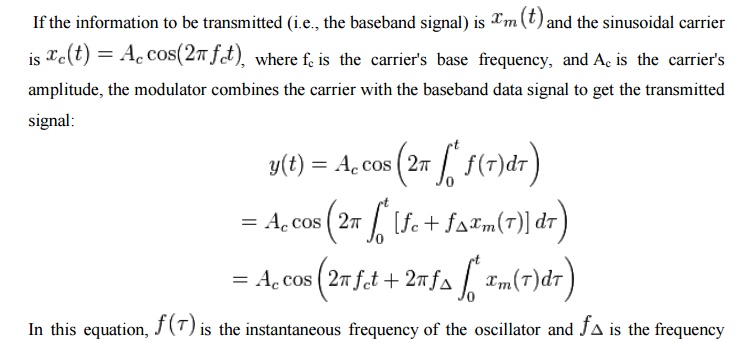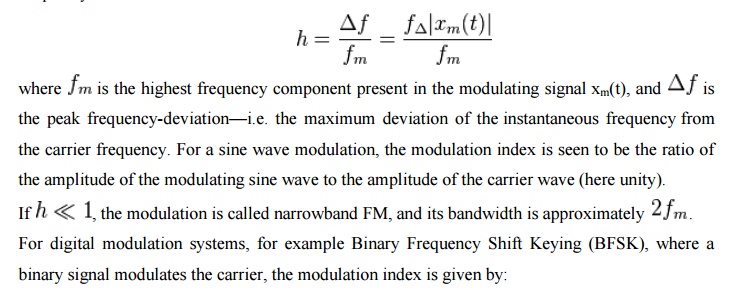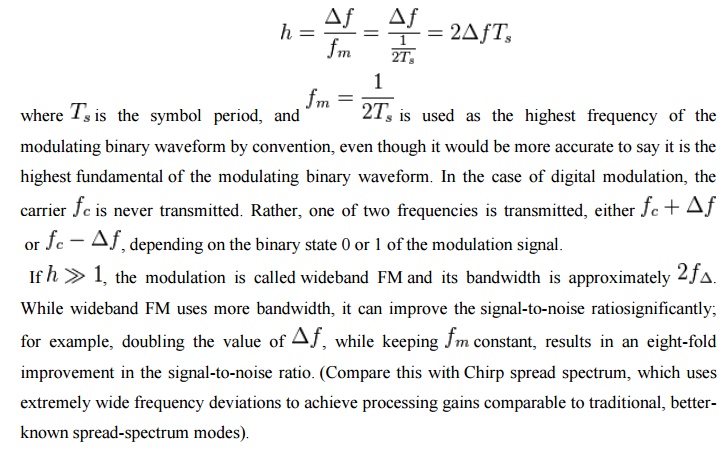Chapter: Communication Theory : Angle Modulation
Frequency & Phase Modulation
FREQUENCY & PHASE MODULATION:
Besides using the amplitude of carrier to
carrier information, one can also use the angle of a carrier to carrier information. This approach
is called angle modulation, and includes frequency modulation (FM) and phase
modulation (PM). The amplitude of the carrier is maintained constant. The major
advantage of this approach is that it allows the trade-off between bandwidth
and noise performance.
An angle modulated signal can be written as
s t = Acosθ(t)
where θ(t) is usually of the form θ
t = 2πfct + ∅(t)
and fc is the carrier frequency. The signal ∅(t) is derived from the message
signal m(t) . If ∅ t = kpm(t) for some constant kp ,the resulting modulation
is called phase
modulation. The parameter kp is
called the phase sensitivity.In telecommunications and
signal processing, frequency modulation (FM) is the encoding of information in
a carrier wave by varying the instantaneous frequency of the wave. (Compare
with amplitude modulation, in which the amplitude of the carrier wave varies,
while the frequency remains constant.) Frequency modulation is known as phase
modulation when the carrier phase modulation is the time integral of the FM
signal.

deviation, which represents the
maximum shift away from fc in one direction, assuming xm(t) is limited to the
range ±1.
While most of the energy of the
signal is contained within fc ± f , it can be shown by Fourier analysis that a
wider range of frequencies is required to precisely represent an FM signal. The
frequency spectrum of an actual FM signal has components extending infinitely,
although their amplitude decreases and higher-order components are often
neglected in practical design problems.
Sinusoidal
baseband signal:
Mathematically,
a baseband modulated signal may be approximated by a sinusoidal continuous wave
signal with a frequency fm.
The
integral of such a signal is:

where the amplitude Am of the modulating sinusoid is represented by the peak deviation fD
The
harmonic distribution of a sine wave carrier modulated by such a sinusoidal
signal can be represented with Bessel functions; this provides the basis for a
mathematical understanding of frequency modulation in the frequency domain.
ü Modulation
index:
As in
other modulation systems, the value of the modulation index indicates by how
much the modulated variable varies around its unmodulated level. It relates to
variations in the carrier frequency:


With a
tone-modulated FM wave, if the modulation frequency is held constant and the
modulation index is increased, the (non-negligible) bandwidth of the FM signal
increases but the spacing between spectra remains the same; some spectral
components decrease in strength as others increase. If the frequency deviation
is held constant and the modulation frequency increased, the spacing between
spectra increases.
Frequency
modulation can be classified as narrowband if the change in the carrier
frequency is about the same as the signal frequency, or as wideband if the
change in the carrier frequency is much higher (modulation index >1) than
the signal frequency. [6] For example, narrowband FM is used for two way radio
systems such as Family Radio Service, in which the carrier is allowed to
deviate only 2.5 kHz above and below the center frequency with speech signals
of no more than 3.5 kHz bandwidth. Wideband FM is used for FM broadcasting, in
which music and speech are transmitted with up to 75 kHz deviation from the
center frequency and carry audio with up to a 20-kHz bandwidth.
Carson's
rule:
BT = 2(Df+fm)
Related Topics